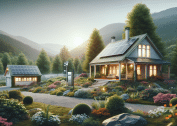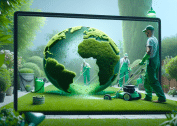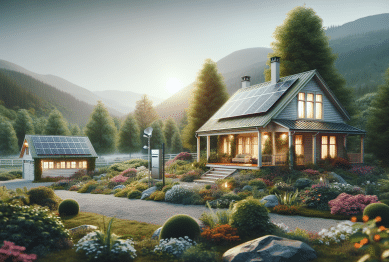Curious how smart garden solutions are changing the way people approach landscaping and home living? Explore practical tips, affordable upgrades, and eco-friendly habits that can help anyone create a low-maintenance, beautiful, and sustainable outdoor space.
Understanding Smart Garden Trends for Homes
Smart garden trends are reshaping how families and individuals design outdoor spaces for comfort, sustainability, and efficiency. Many homeowners are integrating smart irrigation systems that monitor weather and soil conditions, ensuring every plant receives the right amount of water. This not only helps conserve resources but also encourages a healthier lawn and vibrant flower beds. With the integration of smartphone-compatible controllers, people can manage their gardens from anywhere, which appeals to tech-savvy and busy lifestyles alike.
The popularity of low-maintenance landscaping has been on the rise as well. Replacing traditional lawns with drought-tolerant plants and native species reduces workload and water use. Eco-conscious residents increasingly choose pollinator gardens, which support local ecosystems by attracting bees and butterflies. Smart lighting with solar-powered LED fixtures is another new favorite, adding beauty and safety to paths and patios while keeping energy costs in check.
People are also exploring edible gardens and vertical growing spaces. These trends let people cultivate vegetables and herbs even in small city yards or on balconies—making fresh produce more accessible. The overall focus on sustainability, convenience, and innovation is guiding how individuals look to the future of their home gardens. Ultimately, smart garden technologies offer greater control over the environment and inspire continuous improvements to outdoor living.
Benefits of Integrating Technology into Your Garden
Technology in the garden is no longer just a novelty; it’s reshaping the daily experience for many. Sensor-based irrigation systems respond to soil moisture and real-time weather updates to prevent overwatering or neglect. These improvements create healthier plants while saving water—critical in areas that face drought. Automated robotic lawn mowers can maintain a consistently manicured lawn, removing the need for weekly mowing sessions and reducing emissions from traditional gasoline mowers.
Outdoor lighting automation lets homeowners schedule lights around patios, walkways, and entrances, improving safety and ambiance. Paired with solar panels, this setup is both cost-effective and eco-friendly. Smart soil sensors track plant health and send data straight to mobile devices, making it easier to troubleshoot issues before they escalate. These high-tech approaches free up time for relaxation and enjoyment rather than routine labor.
Tech integration doesn’t just save time—it can also foster inclusivity and accessibility. Features like voice-activated watering systems or remote-controlled planters are helpful for older adults and those with mobility challenges. Families with children find value in educational apps that gamify gardening, cultivating a love for nature and practical eco-skills. The result is a more enjoyable, stress-free, and productive gardening experience for everyone involved.
Making Outdoor Spaces Sustainable and Low Maintenance
A key focus of modern garden design is sustainable landscaping. Shifting to drought-resistant ground cover, mulching with organic materials, and using compost made from kitchen waste not only benefits the environment but also cuts down on weekly chores. Rainwater harvesting systems, another top trend, provide a renewable water source to nourish gardens without increasing utility bills.
Rain gardens and permeable pavers help manage stormwater runoff, protecting local waterways while keeping yards lush and green. Homeowners who switch to native plants find their gardens more resistant to pests and disease, which means fewer chemical treatments and less intervention needed overall. Planting with biodiversity in mind encourages natural pollination processes and can even act as a tiny wildlife refuge.
The rise of vertical gardens makes it possible to grow more with less space and minimal soil. Climbers, wall-mounted pots, and trellis arrangements turn blank fences or walls into productive and visually stunning green spaces. These sustainable design strategies foster a healthy relationship with nature, reducing reliance on chemicals and heavy manual work while promoting environmental stewardship in urban and suburban areas.
Smart Garden Upgrades for Every Budget
Smart garden enhancements are available for a wide range of budgets. For those making small investments, affordable timers, moisture sensors, and solar pathway lights offer tangible benefits without major up-front costs. These upgrades let gardeners begin the transition to a more automated system while watching how each device contributes to overall garden health.
Mid-range options include modular raised beds with self-watering inserts or purchasing energy-efficient smart pumps for ponds and water features. Some even opt for basic weather stations that sync with home Wi-Fi, giving them detailed insights on local conditions. Larger budgets allow families to explore advanced systems like robotic mowers, fully integrated app-controlled irrigation, and landscape lighting clusters connected to voice assistants.
People are increasingly creative in combining DIY smart garden devices with established tech platforms. Using open-source software, some assemble custom watering schedules or connect their gardens to weather forecast apps. Upgrading outdoor spaces doesn’t require a complete overhaul; incremental additions can gradually boost efficiency, aesthetics, and enjoyment year-round.
Eco-Friendly Practices for the Modern Home Gardener
Sustainability is at the heart of modern gardening, and eco-friendly choices are more accessible than ever. Using organic mulch, planting cover crops in off-seasons, and minimizing pesticide use protects both wildlife and human health. Composting kitchen and yard waste transforms potential landfill contributions into a rich, soil-amending resource.
Collecting rainwater for irrigation and selecting plants that thrive locally reduces strain on municipal water systems and lowers costs. Smart composters with odor control and fast processing cycles fit into compact homes, fostering zero-waste habits that benefit the whole household. Eco-conscious gardeners also use natural fertilizers like fish emulsion or compost tea, lessening the environmental footprint of chemical alternatives.
Recently, community garden networks and knowledge-sharing platforms have helped spread green techniques. These resources guide new gardeners through every step of the process, from soil testing to pest management. Eco-friendly gardening adapts to every skill and interest level, making it both a rewarding hobby and a vital contribution to a healthier environment.
Inspiring Creative Spaces with Smart and Sustainable Design
The modern backyard or balcony can serve as a personal retreat, a mini-farm, or a pollinator paradise thanks to smart design. Integrating modular planters, moveable trellises, and weatherproof sound systems creates inviting zones for relaxation and entertainment. Homeowners find inspiration in mixing culinary herbs, climbing veggies, and ornamentals to blend beauty with bounty.
Pergolas outfitted with solar string lights or rain sensors that close water features during storms are just two examples of hybrid approaches. Merging technology and sustainable materials, people are redefining what constitutes a functional and attractive garden. Smart garden design often borrows ideas from commercial landscaping, such as zoning by plant type or grouping by water needs for efficiency.
Social trends push urban dwellers to maximize both beauty and utility. Small patios become productive with vertical lettuce towers, while large lawns transform into pollinator highways. Creative, data-driven, and eco-friendly upgrades continue to inspire more enjoyable outdoor spaces and motivate others to adopt sustainable practices wherever they live.
References
1. Environmental Protection Agency. (n.d.). Greening Your Garden. Retrieved from https://www.epa.gov/soakuptherain/soak-rain-greening-your-garden
2. United States Department of Agriculture. (n.d.). Gardening for Pollinators. Retrieved from https://www.usda.gov/peoples-garden/pollinators
3. National Wildlife Federation. (n.d.). Sustainable Gardening Practices. Retrieved from https://www.nwf.org/Home/Garden-for-Wildlife/Gardening-Tips/Sustainable-Gardening
4. Energy.gov. (n.d.). Solar Lighting for Your Home. Retrieved from https://www.energy.gov/energysaver/solar-lighting
5. University of California Agriculture and Natural Resources. (n.d.). Lawn Watering Guide. Retrieved from https://cesonoma.ucanr.edu/Vegetable_Garden_Problems/Sustainable_Landscape/Lawn_Watering_Guide/
6. Penn State Extension. (n.d.). Water-Saving Gardening Tips. Retrieved from https://extension.psu.edu/water-saving-gardening-tips









